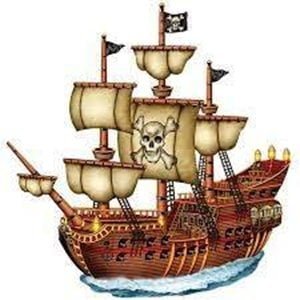
A letter of marque was given by governments in the 16,17 & 18th Centuries as a licence for a private person to attack and capture ships of a nation with which that government was at war.
They legalised piracy.
It is the only way to describe it, it was that, legalised piracy. Some governments did more than that they even honoured the pirates.
The knighthood for Sir Francis Drake
For example, on 1 April 1581, Queen Elizabeth I stood on the deck of Francis Drake’s ship The Golden Hind, she handed her state sword to the French Ambassador who then knighted one of the richest pirates of the time, Francis Drake.
The excuse for the knighthood was that Sir Francis Drake, and his crew had covered 36,000 miles to circumnavigate the world, they weren’t the first, but they had done it.
That was the public reward, the real one was that the Queen had agreed to split with him whatever he could plunder on the trip. Plunder he did. He plundered galleons, he sacked ports so that by the time he came home, he was the world’s richest pirate and he split these gains with the queen. That is the real reason he was knighted.
The consequences of this knighthood.
Unfortunately, I believe that it was these actions that were the key reasons that King Philip of Spain started the Armada, he had annoyed the King so much, which, actually, I think Drake had done purposely.
The Musical.
The Armada is such an important event in our history that we have publish a 50 minute musical for Key Stage 2 and 3 children, it is called The Spanish Armada – The Invasion of England with 12 original and entertaining songs to take the story along.
Go to https://educationalmusicals.co.uk/?product=the-spanish-armada which takes you to the show at http://www.educationalmusicals.co.uk
Let’s Make History Fun.
10 questions to discuss:
- What was a letter of marque and how did it function as a license for private individuals during the 16th, 17th, and 18th centuries?
- How did governments justify issuing letters of marque, and what implications did they have on international maritime law?
- Can you explain the concept of legalised piracy in the context of letters of marque during the mentioned centuries?
- What notable historical figures received recognition for their piracy activities, and how were they honored by their governments?
- Describe the significance of Queen Elizabeth I’s knighthood of Sir Francis Drake and its connection to piracy.
- How did the circumnavigation of the world by Sir Francis Drake contribute to his knighthood and his status as a pirate?
- What were the economic implications of Queen Elizabeth I agreeing to split plunder with Sir Francis Drake?
- How did Sir Francis Drake’s actions, including piracy and plundering, contribute to tensions between England and Spain, leading to events such as the Spanish Armada?
- What role did Sir Francis Drake play in aggravating King Philip of Spain, and how did this contribute to the geopolitical climate of the time?
- In what ways did the actions of individuals like Sir Francis Drake shape the course of naval warfare and international relations during the 16th, 17th, and 18th centuries?
Some other interesting places to look:
© Tony Dalton

